Search Result
Results for "
Glioblastoma Inhibitors
" in MedChemExpress (MCE) Product Catalog:
5
Isotope-Labeled Compounds
| Cat. No. |
Product Name |
Target |
Research Areas |
Chemical Structure |
-
- HY-147011
-
|
|
Fat Mass and Obesity-associated Protein (FTO)
|
Cancer
|
|
FTO-IN-7 is an inhibitor of FTO. FTO-IN-7 can be used in study Alzheimer's diseases, breast cancers, small-cell lung cancers,a human bone marrow striated muscle cancer, a pancreatic cancer, malignant glioblastoma .
|
-

-
- HY-12401A
-
|
|
Mps1
|
Cancer
|
|
Mps1-IN-3 hydrochloride is a potent and selective Mps1 inhibitor with an IC50 value of 50 nM. Mps1-IN-3 hydrochloride can inhibit the proliferation of glioblastoma cells, and effectively sensitizes glioblastomas to Vincristine in orthotopic glioblastoma xenograft model .
|
-
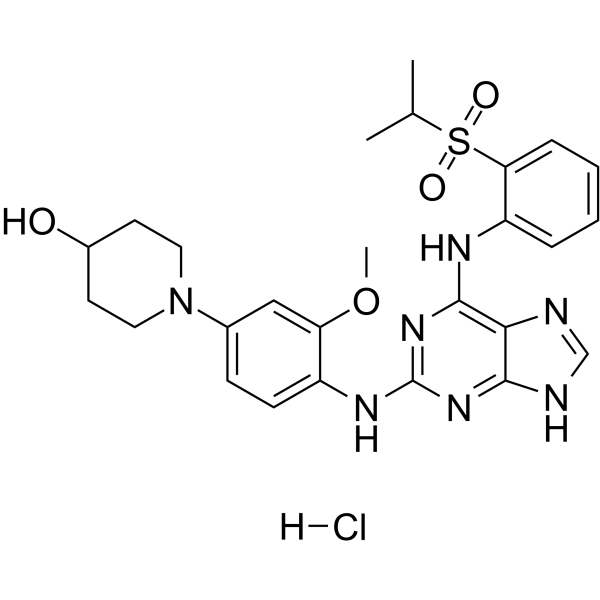
-
- HY-157975
-
|
|
Glutaminase
|
Cancer
|
|
LM11 is an inhibitor of transglutaminase 2 (TG2) with an activity of killing glioblastoma cells by maintaining TG2 in a cytotoxic conformational state .
|
-
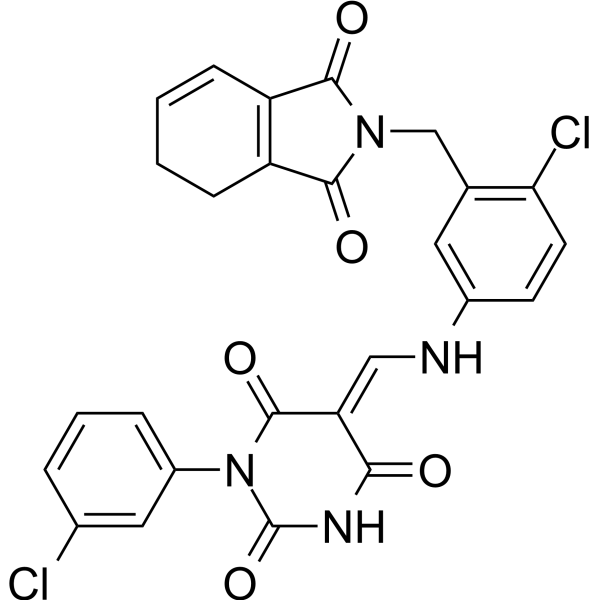
-
- HY-120115
-
|
Olaparib-bodipy FL
|
PARP
|
Cancer
|
|
PARPi-FL is a small molecule and fluorescent inhibitor of PARP1. PARPi-FL is a highly selective probe and can be used as an imaging agent to detect glioblastomas in vivo .
|
-
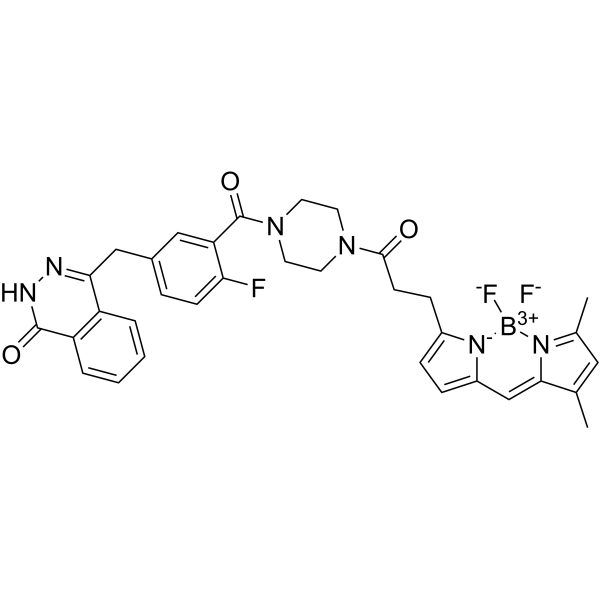
-
- HY-146275
-
|
|
LXR
|
Cancer
|
|
LXRβ agonist-3 (compound 4-13) is a potent and selective LXRβ (liver X receptor β) agonist, with an EC50 of 0.095 μM. LXRβ agonist-3 efficiently inhibits U87EGFRvIII cell, with an IC50 of 3.75 μM. LXRβ agonist-3 shows antitumor activity, and can inhibit glioblastoma .
|
-

-
- HY-B0114
-
|
GP 47680
|
Sodium Channel
Apoptosis
|
Neurological Disease
Cancer
|
|
Oxcarbazepine is a sodium channel blocker . Oxcarbazepine significantly inhibits glioblastoma cell growth and induces apoptosis or G2/M arrest in glioblastoma cell lines . Anti-cancer and anticonvulsant effects .
|
-

-
- HY-153773
-
|
|
IRE1
|
Cancer
|
|
Z4P is a BBB-permeable IRE1 inhibitor (IC50: 1.11 μM). Z4P inhibits Glioblastoma cell growth. Z4P prevents glioblastoma relapse when administered together with Temozolomide (HY-17364) .
|
-
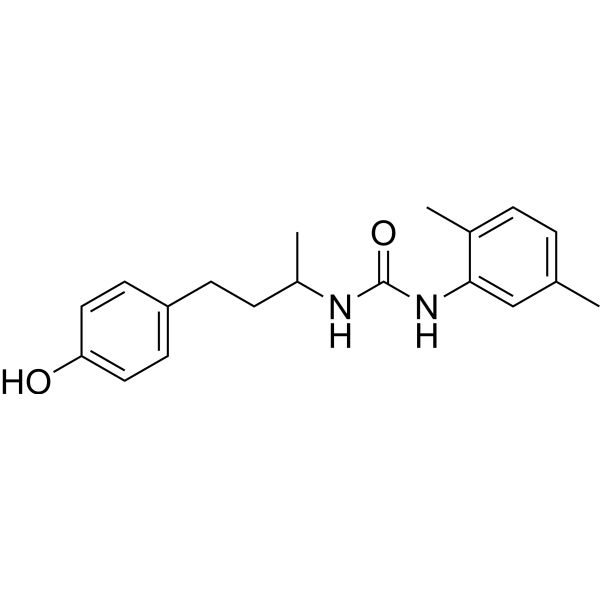
-
- HY-P4115
-
|
|
FABP
|
Cancer
|
|
CooP is a linear glioblastoma-targeting nonapeptide. CooP binds to the mammary-derived growth inhibitor/fatty acid binding protein 3 (FABP3) in the glioblastoma cells and its associated vasculature. CooP is used for the targeted delivery of chemotherapy and different nanoparticles .
|
-

-
- HY-163193
-
|
|
Atg4
Autophagy
|
Cancer
|
|
MJO445 (Compound 7) is a ATG4B inhibitor, which inhibits the autophagy of glioblastoma .
|
-
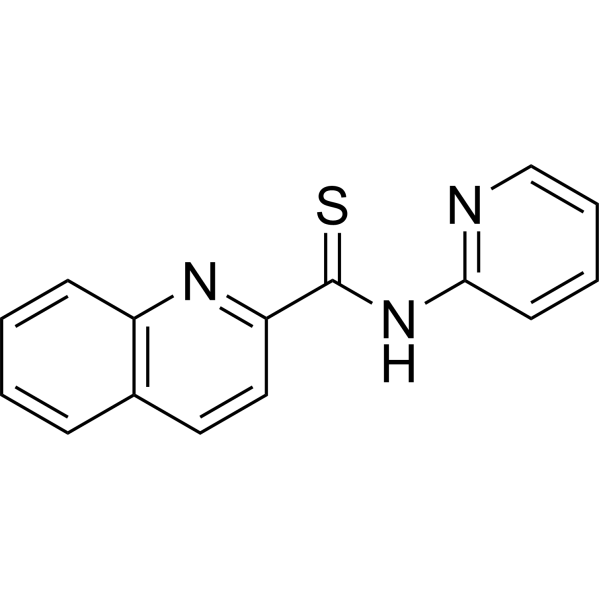
-
- HY-132865
-
-
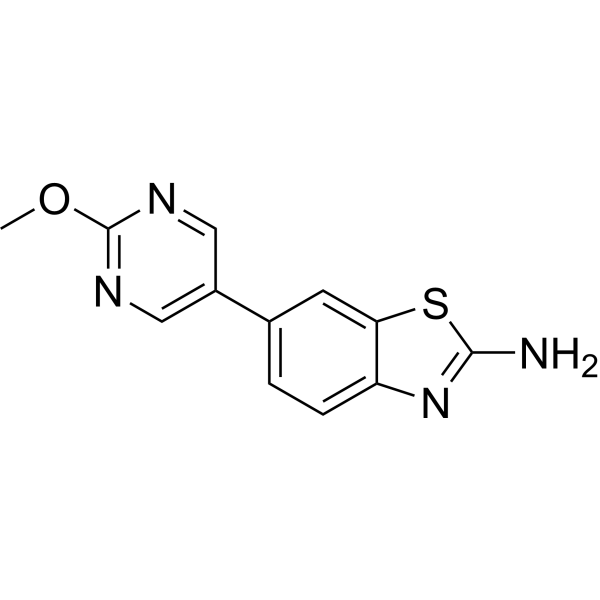
-
- HY-132863
-
-

-
- HY-N8835
-
-
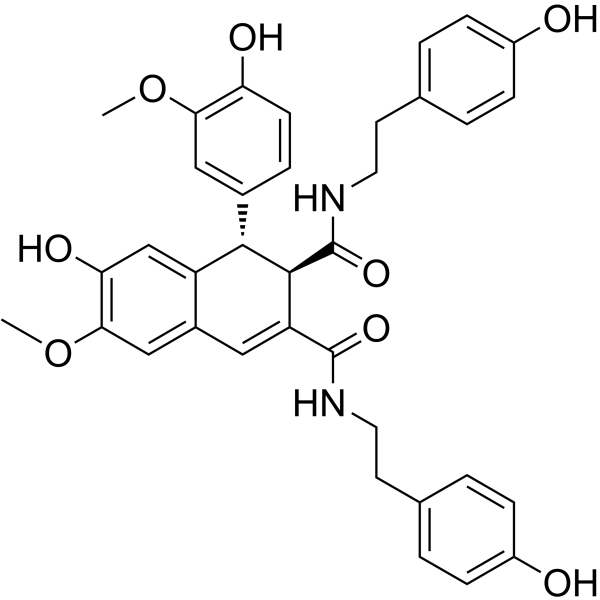
-
- HY-B0114S2
-
|
GP 47680-d8
|
Sodium Channel
Apoptosis
|
Neurological Disease
Cancer
|
|
Oxcarbazepine-d8-1 is a deuterium of Oxcarbazepine. Oxcarbazepine is a sodium channel blocker . Oxcarbazepine significantly inhibits glioblastoma cell growth and induces apoptosis or G2/M arrest in glioblastoma cell lines . Oxcarbazepine? has anti-cancer and anticonvulsant effects .
|
-

-
- HY-N12535
-
|
|
Others
|
Cancer
|
|
Tagitinin C is a sesquiterpenoid compound isolated from the Tithonia diversifolia. Tagitinin C has anticancer activity and can inhibit the proliferation of human glioblastoma U373 cells with an IC50 of 6.1 μg/mL. Tagitinin C can induce U373 cell death and be used in glioblastoma research .
|
-
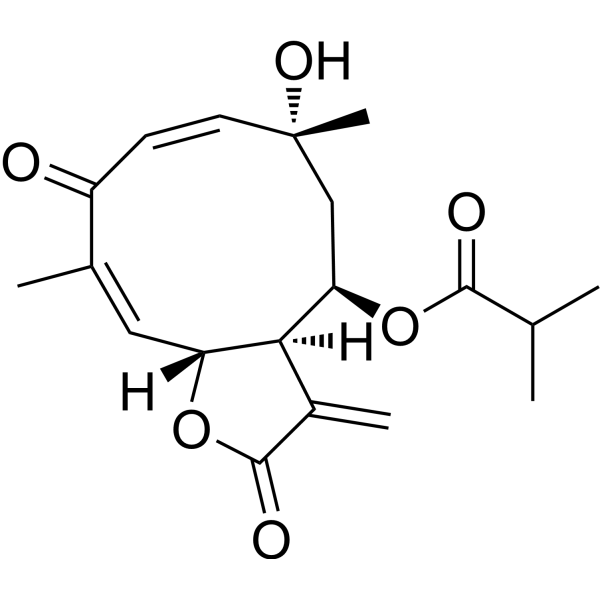
-
- HY-15735
-
|
|
c-Met/HGFR
|
Cancer
|
|
c-Met inhibitor 1 is an inhibitor of the c-Met receptor signaling pathway useful for the treatment of cancer including gastric, glioblastoma, and pancreatic cancer.
|
-

-
- HY-B0114S1
-
-

-
- HY-149374
-
|
|
Microtubule/Tubulin
|
Cancer
|
|
Tubulin inhibitor 36 (Compound 10) is a novel and potent tubulin inhibitor and inhibits the polymerization of microtubular protein then induces apoptosis with an IC50 value of 1.5±0.1 μM. Tubulin inhibitor 36 (Compound 10) has significant anti-mitotic effect and exhibits activities against glioblastoma cells. Tubulin inhibitor 36 (Compound 10) has anti-tumor effects and can be used for glioblastoma multiforme (GBM) research .
|
-
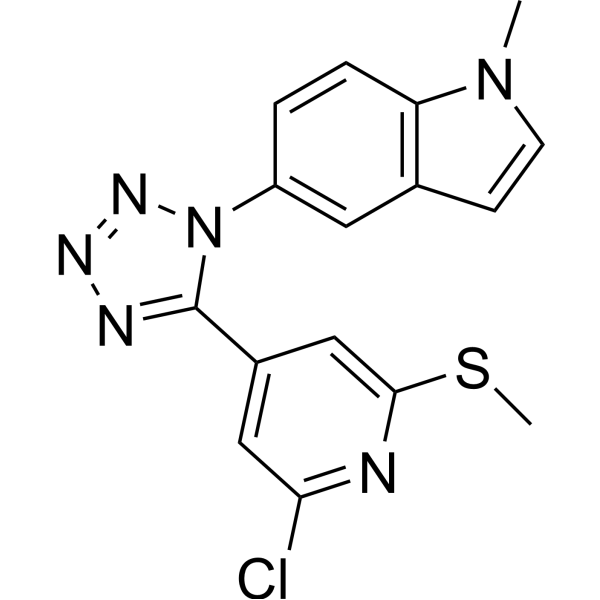
-
- HY-111651
-
-
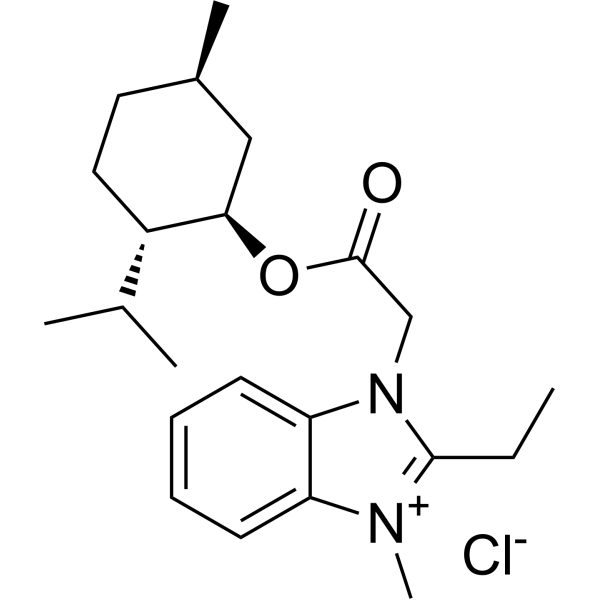
-
- HY-111652
-
|
|
Others
|
Cancer
|
|
S-Gboxin, a functional analogue of Gboxin, inhibits growth of mouse and human glioblastoma (GBM) with an IC50 of 470 nM . Antitumour activity .
|
-
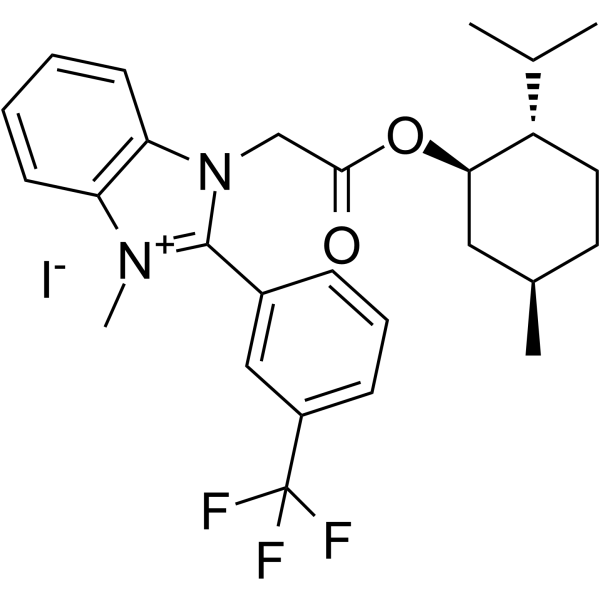
-
- HY-133570
-
|
|
HSP
ADC Cytotoxin
|
Cancer
|
|
17-AEP-GA, an HSP90 antagonist, is a potent inhibitor of glioblastoma cell proliferation, survival, migration and invasion. ADCs Toxin .
|
-

-
- HY-B0114S
-
|
GP 47680-d4
|
Sodium Channel
Apoptosis
|
Neurological Disease
Cancer
|
|
Oxcarbazepine-d4 (GP 47680-D4) is the deuterium labeled Oxcarbazepine. Oxcarbazepine is a sodium channel blocker[1]. Oxcarbazepine significantly inhibits glioblastoma cell growth and induces apoptosis or G2/M arrest in glioblastoma cell lines[2]. Anti-cancer and anticonvulsant effects[2][3].
|
-

-
- HY-128685
-
|
Ac12Az9
|
P-glycoprotein
BCRP
|
Cancer
|
|
FD 12-9 is a flavonoid dimer, acts as a dual inhibitor of P-gp and BCRP, with EC50s of 285 nM and 0.9 nM, respectively. Anti-glioblastoma activity .
|
-
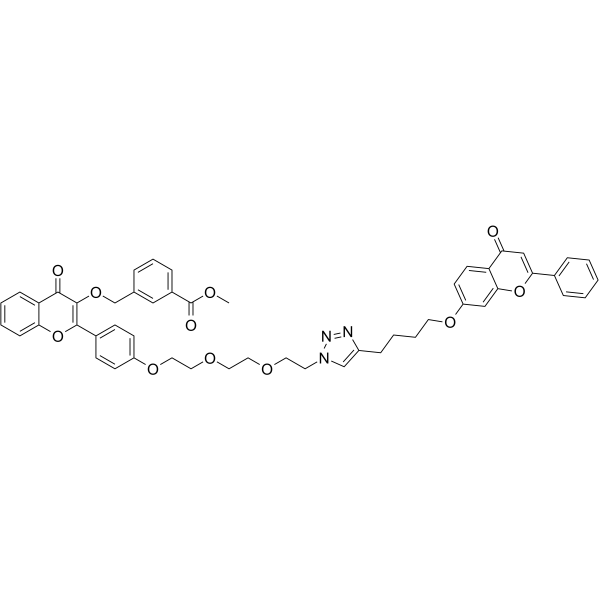
-
- HY-125964
-
|
|
Survivin
|
Cancer
|
|
LLP-3 is a potent Survivin inhibitor that disrupts the Survivin-Ran interaction in cancer cells. LLP-3 can be used in the research of Glioblastoma multiforme (GBM) .
|
-

-
- HY-155272
-
|
|
SHP2
|
Cancer
|
|
SHP2-IN-16 (compound 222) is a SHP2 inhibitor with an IC50 value of 1 nM. SHP2-IN-16 can be used for glioblastoma research .
|
-
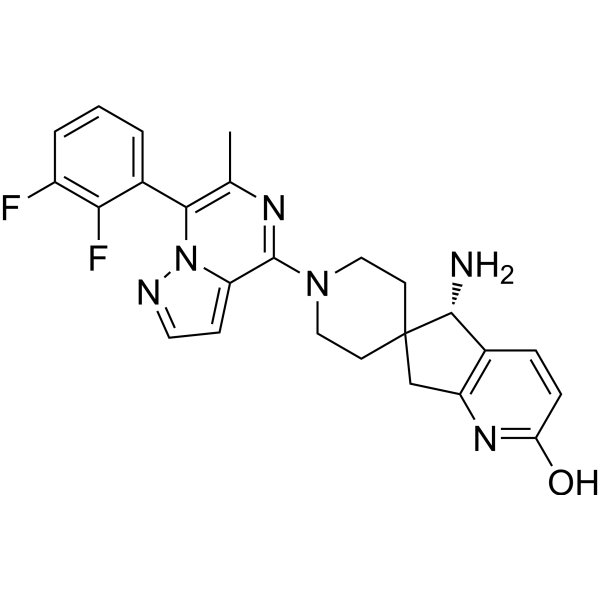
-
- HY-155273
-
|
|
SHP2
|
Cancer
|
|
SHP2-IN-17 (compound 192) is a SHP2 inhibitor with an IC50 value of 2 nM. SHP2-IN-17 can be used for glioblastoma research .
|
-

-
- HY-155274
-
|
|
SHP2
|
Cancer
|
|
SHP2-IN-18 (compound 183) is a SHP2 inhibitor with an IC50 value of 3 nM. SHP2-IN-18 can be used for glioblastoma research .
|
-
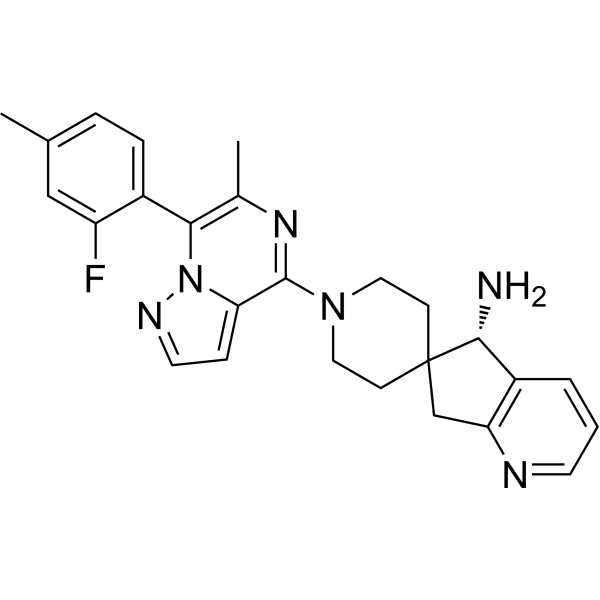
-
- HY-155275
-
|
|
SHP2
|
Cancer
|
|
SHP2-IN-19 (compound 183) is a SHP2 inhibitor with an IC50 value of 3 nM. SHP2-IN-19 can be used for glioblastoma research .
|
-
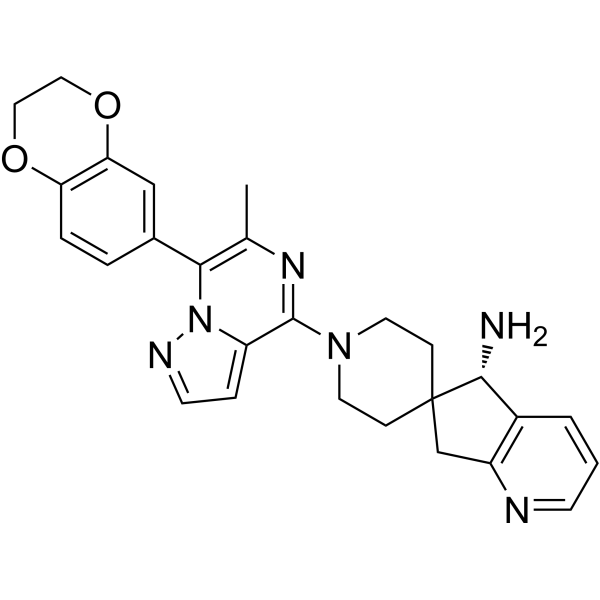
-
- HY-155276
-
|
|
SHP2
|
Cancer
|
|
SHP2-IN-20 (compound 193) is a SHP2 inhibitor with an IC50 value of 3 nM. SHP2-IN-20 can be used for glioblastoma research .
|
-
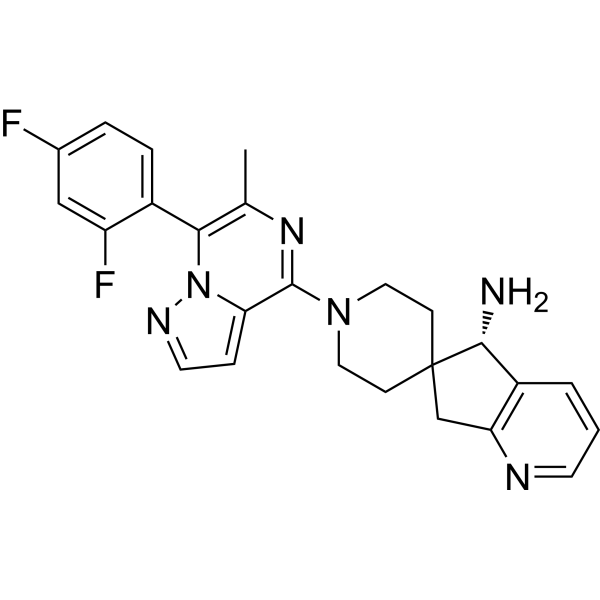
-
- HY-155277
-
|
|
SHP2
|
Cancer
|
|
SHP2-IN-21 (compound 208) is a SHP2 inhibitor with an IC50 value of 3 nM. SHP2-IN-21 can be used for glioblastoma research .
|
-
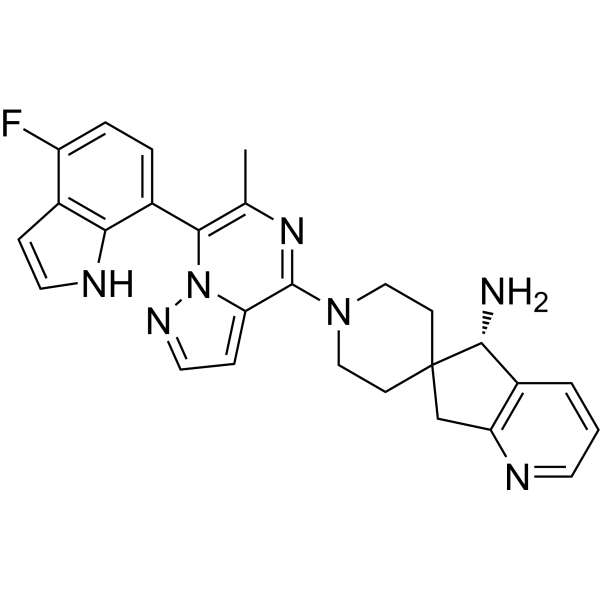
-
- HY-142682
-
|
|
Others
|
Neurological Disease
Cancer
|
|
SCP1-IN-1 (compound SH T-62) is a potent and selective covalent inhibitor against SCP1. SCP1-IN-1 promotes REST degradation and reduces transcriptional activity. A high level of REST protein drives the tumor growth in some glioblastoma cells. SCP1-IN-1 has the potential for the research of glioblastoma whose growth is driven by REST transcription activity .
|
-
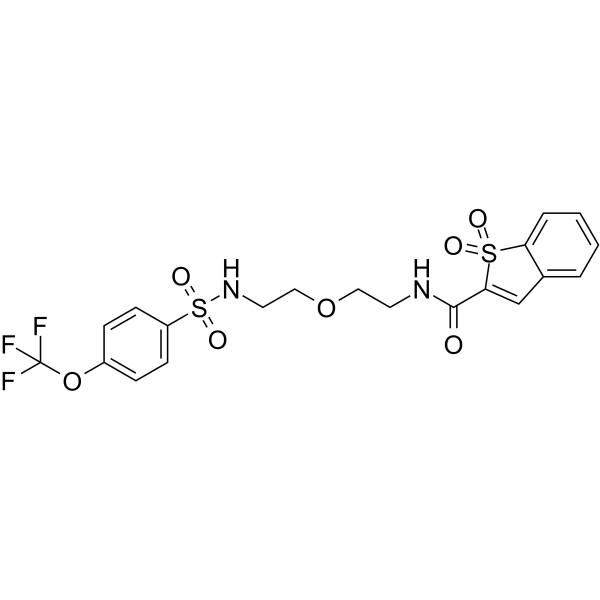
-
- HY-142683
-
|
|
Others
|
Neurological Disease
Cancer
|
|
SCP1-IN-2 (Compound SH T-65) is a potent and selective covalent inhibitor against SCP1. SCP1-IN-2 promotes REST degradation and reduces transcriptional activity. A high level of REST protein drives the tumor growth in some glioblastoma cells. SCP1-IN-2 has the potential for the research of glioblastoma whose growth is driven by REST transcription activity .
|
-
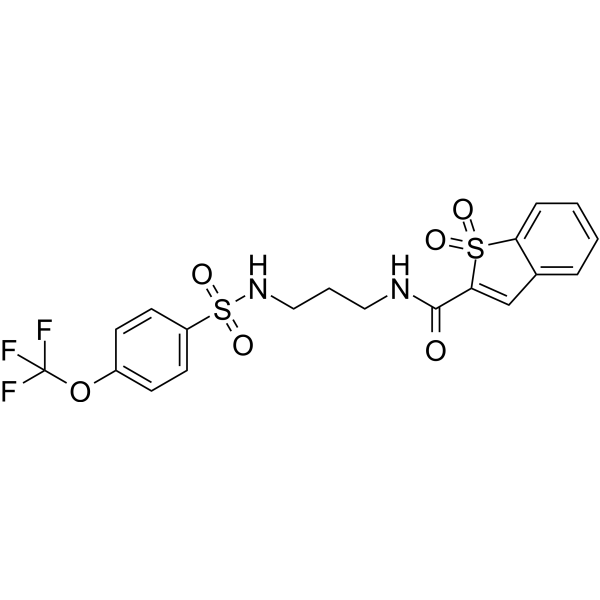
-
- HY-116165
-
|
|
Phospholipase
|
Cancer
|
|
ML298 is a potent and selective inhibitor of Phospholipase D2 (PLD2) with an IC50 of 355 nM. ML298 decreases invasive migration in U87-MG glioblastoma cells .
|
-
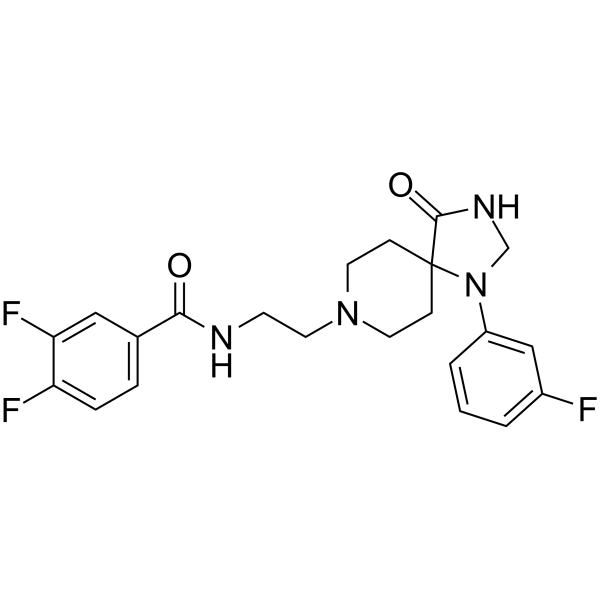
-
- HY-147327
-
|
|
Others
|
Cancer
|
|
N-Formylsarcolysine has antitumor activity, and inhibits leukemia by increasing the Hb and erythrocyte levels and decreasing the number of leukocytes. N-Formylsarcolysine also involves in glioblastoma and other diseases research .
|
-
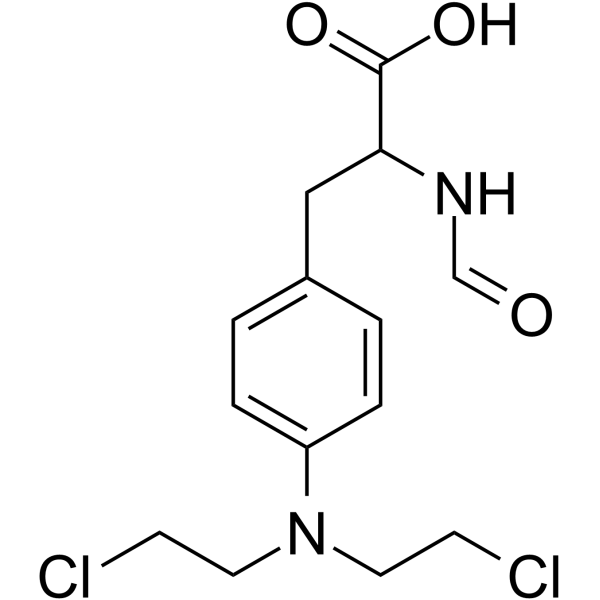
-
- HY-125427
-
|
|
OLIG2
|
Cancer
|
|
SKOG102 is a potent OLIG2 inhibitor that is directly engaging OLIG2 and interferes with the ability of OLIG2 to bind DNA. SKOG102 can be used for the research of glioblastoma (GBM) .
|
-

-
- HY-100475
-
|
|
|
|
|
KYP-2047 is a potent and BBB-penetrating prolyl-oligopeptidase (POP) inhibitor, with an Ki value of 0.023 nM. KYP-2047 reduces glioblastoma proliferation through angiogenesis and apoptosis modulation .
|
-
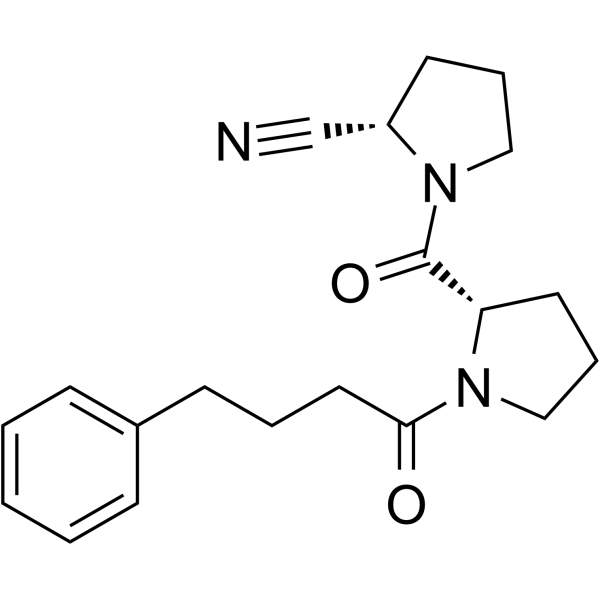
-
- HY-152203
-
|
|
Others
|
Cancer
|
|
Mitochondrial respiration-IN-2 is the fluorine derivative of Virginiamycin M1 (HY-N6686). Mitochondrial respiration-IN-2 can inhibit mitochondrial translation of glioblastoma stem cells .
|
-
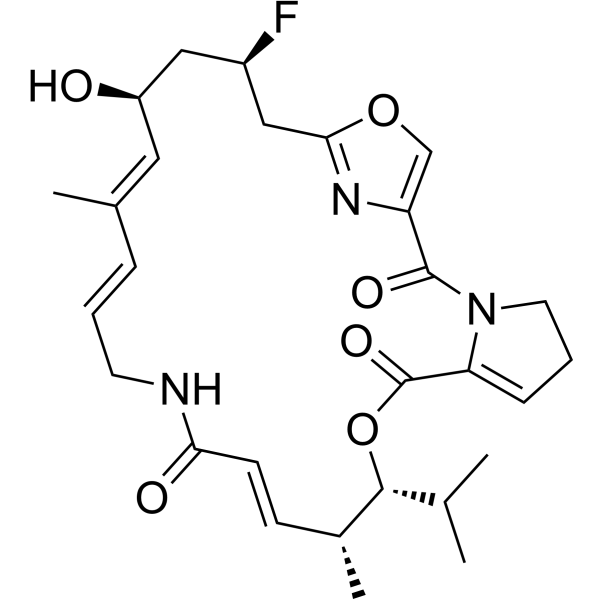
-
- HY-124582
-
|
|
Autophagy
mTOR
|
Cancer
|
|
NEO214 is an autophagy inhibitor and a covalent conjugate of the PDE4 inhibitor Rolipram (HY-16900) and perillyl alcohol (HY-N7000). It has anti-cancer activity and blood-brain barrier (BBB) permeability. Over sex. NEO214 prevents autophagy-lysosome fusion, thereby blocking autophagic flux and triggering glioma cell death. The process involves mTOR activation, andTFEB(Transcription Factor EB) aggregation. NEO214 inhibitionMacroautophagy/autophagy in glioblastoma cells has the potential to overcome chemotherapy resistance in glioblastoma .
|
-

-
- HY-161256
-
|
|
Microtubule/Tubulin
Apoptosis
|
Cancer
|
|
Tubulin inhibitor 41 (Compd D19), a promising anti-GBM (glioblastoma) lead compound and tublin inhibitor with BBB permeability, induces G2/M phase arrest, resulted in cell apoptosis and inhibits the migration of U87 cells .
|
-

-
- HY-13703A
-
|
ACNU
|
DNA/RNA Synthesis
DNA Alkylator/Crosslinker
Apoptosis
|
Cancer
|
|
Nimustine hydrochloride (ACNU) is a DNA cross-linking and DNA alkylating agent, which induces DNA replication blocking lesions and DNA double-strand breaks and inhibits DNA synthesis, commonly used in chemotherapy for glioblastomas .
|
-
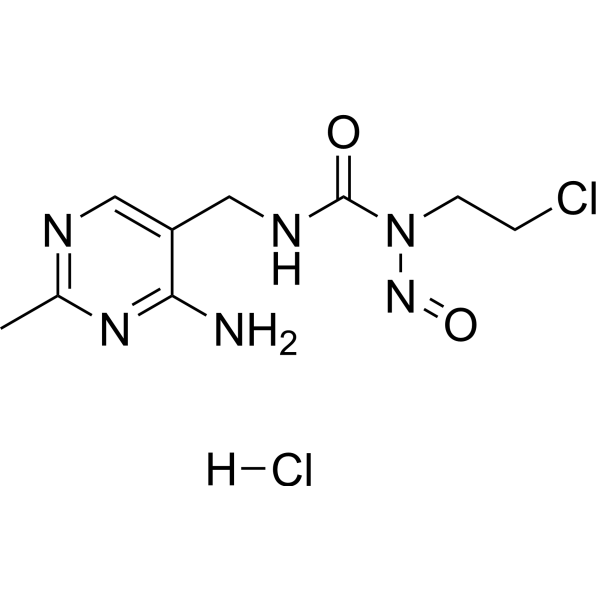
-
- HY-116273
-
|
|
Phospholipase
|
Cancer
|
|
ML299 is a selective allosteric modulator and a dual inhibitor of phospholipases D1 and D2 (IC50 values are 6 and 12 nM, respectively). ML299 decreases invasive migration in U87-MG glioblastoma cells .
|
-

-
- HY-157168
-
|
|
Trk Receptor
|
Neurological Disease
|
|
TrkA-IN-6 (compound R48) is a hydrazone-like, selective inhibitor of tropomyosin kinase type A receptor kinase (TrkA). TrkA-IN-6 exhibited a higher cytotoxic effect on U87 GBM cells than Temozolomide (HY-17364), with an IC50 of 68.99 μM .
|
-

-
- HY-14942
-
|
RTA 744 free base; WP 744 free base; WP 769
|
Others
|
Cancer
|
|
Berubicin (RTA 744 free base; WP 744) is a 4'-O-benzyldoxorubicin that inhibits P-gp and MRP1-mediated efflux and has anticancer activity. Berubicin inhibits glioblastoma multiforme (GBM) and exhibits cytotoxicity. Berubicin has poor bioavailability in mice .
|
-
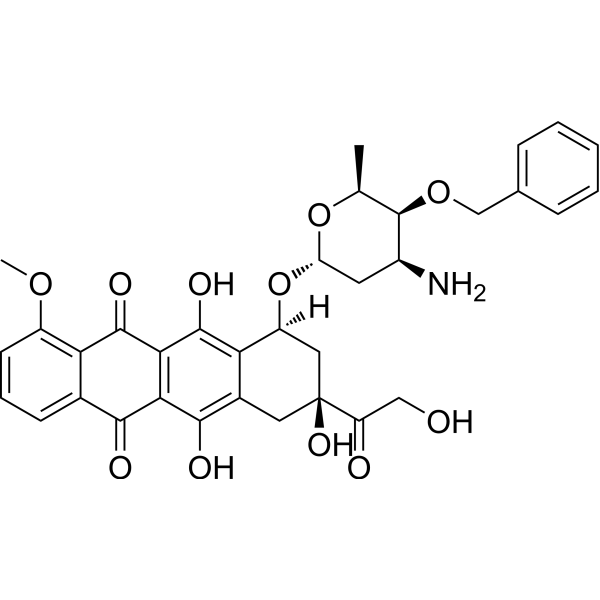
-
- HY-149530
-
|
|
EGFR
Apoptosis
|
Cancer
|
|
EGFR-IN-86 (compound 4i) is an EGFR inhibitor (IC50: 1.5 nM) with high activity against glioblastoma. EGFR-IN-86 induces apoptosis and arrests the U87 cell cycle in the G2/M phase .
|
-
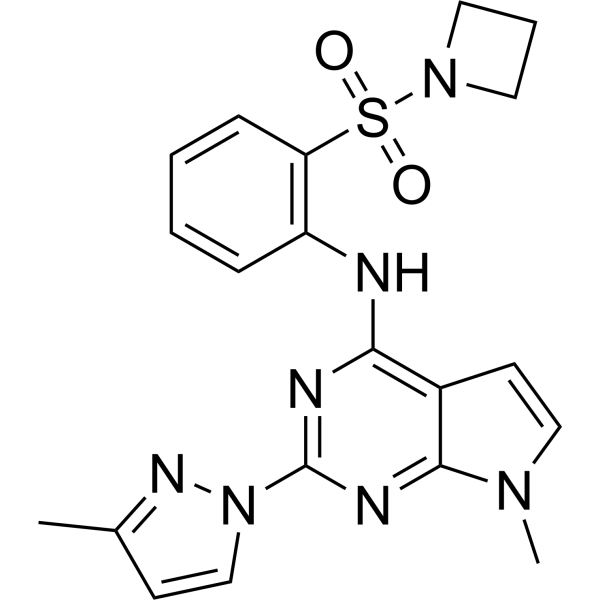
-
- HY-12616
-
|
|
LPL Receptor
|
Cancer
|
|
ACT-209905 is a S1P1 receptor agonist. ACT-209905 can inhibit glioblastoma (GBM) cell growth and migration. ACT-209905 also has immunomodulating activity, and can be used in research of autoimmune diseases .
|
-

-
- HY-17595
-
|
|
Parasite
Apoptosis
Microtubule/Tubulin
|
Infection
Cancer
|
|
Mebendazole is a highly effective, broad-spectrum antihelmintic against nematode infestations. Mebendazole also exhibits inhibitory effect against glioblastoma multiforme (GBM), inhibits Hedgehog pathway and tubulin polymerization. Mebendazole is orally active and can cross CNS penetration .
|
-
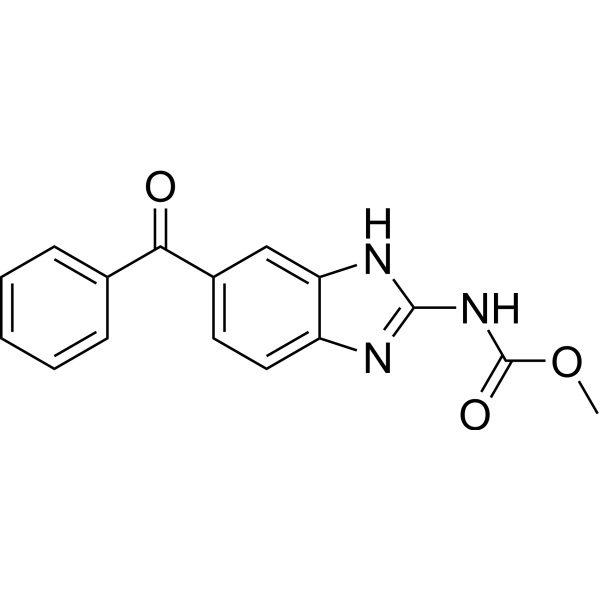
-
- HY-P99768
-
|
TTAC-0001
|
VEGFR
|
Cancer
|
|
Olinvacimab (TTAC-0001) is a fully human anti-VEGFR2 monoclonal antibody. Olinvacimab inhibits VEGF binds to KDR with a Kd value of 0.23 nM. Olinvacimab has antiangiogenic activity. Olinvacimab can be used for the research of recurrent glioblastoma and breast cancer .
|
-

-
- HY-126771
-
|
Chr-A
|
Antibiotic
Bacterial
Akt
GSK-3
β-catenin
c-Myc
|
Infection
Cancer
|
|
Chrysomycin A (Chr-A), an antibiotic, can be obtained from Streptomyces. Chrysomycin A exhibits antitumor and anti-tuberculous and MRSA activities. As for glioblastoma, Chrysomycin A inhibits the proliferation, migration, and invasion of cancer cells through the Akt/GSK-3β/β-catenin signaling pathway .
|
-
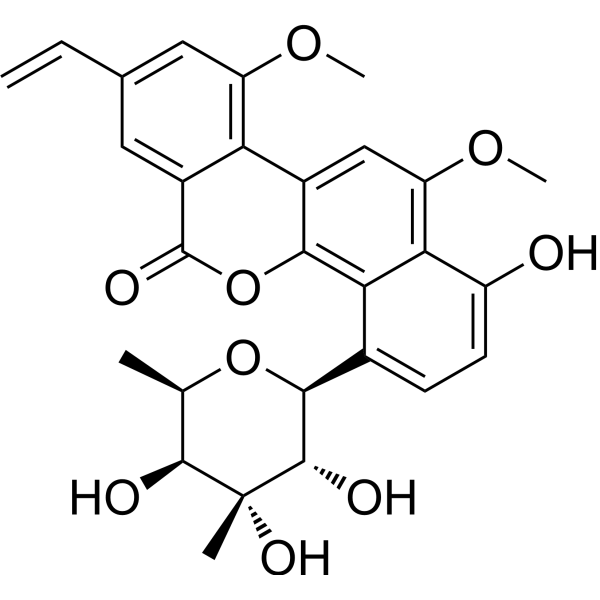
-
- HY-149515
-
|
|
Monoamine Oxidase
|
Cancer
|
|
MAO-IN-3 (Compound 5) is a reversible and competitive MAO inhibitor (Ki: 0.6 and 0.2 μM for MAO A and MAO B). MAO-IN-3 inhibits LN-229 glioblastoma cell proliferation with an IC50 of 0.8 μM. MAO-IN-3 can be used for cancer research .
|
-

-
- HY-14590
-
-
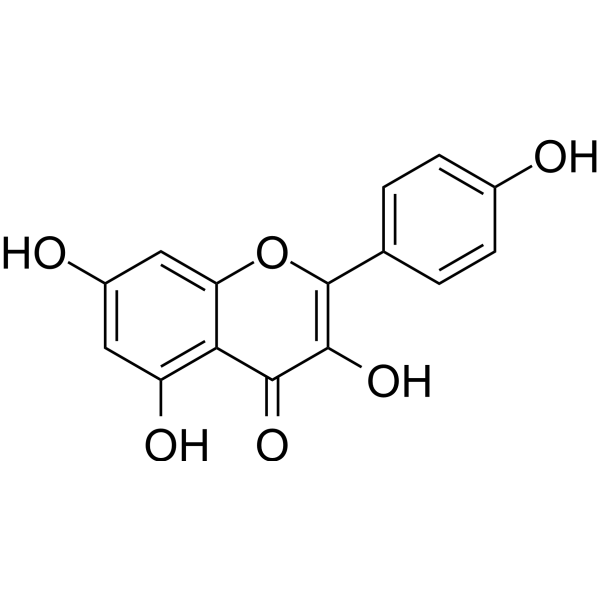
-
- HY-P3990
-
|
|
VEGFR
Autophagy
Apoptosis
|
Cancer
|
|
Coibamide A, an N-methyl-stabilized cytotoxic depsipeptide, shows potent antiproliferative activity. Coibamide A induces autophagosome accumulation via an mTOR-independent mechanism. Coibamide A induces apoptosis. Coibamide A inhibits VEGFA/VEGFR2 expression and suppresses tumor growth in glioblastoma xenografts .
|
-
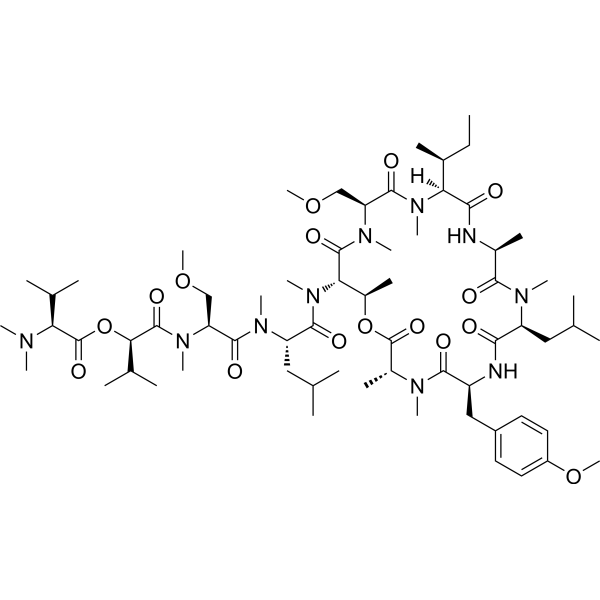
- HY-112293
-
|
|
EGFR
|
Cancer
|
|
GW2974 is a potent dual inhibitor of EGFR and HER2 with IC50 value of 0.007 μM and 0.016 μM, respectively. GW2974 demonstrates in vitro inhibition of the EGFR and HER2 and inhibits the growth of tumor cell. GW2974 can be used for glioblastoma multiforme (GBM) disease research .
|
-

- HY-126244
-
|
|
CDK
|
Cancer
|
|
CDK4/6-IN-3 is a brain-penetrant CDK4/CDK6 inhibitor with Kis of <0.3 nM and 2.2 nM, respectively. CDK4/6-IN-3 inhibits CDK1 with a Ki of 110 nM. CDK4/6-IN-3 can be used for the treatment of glioblastoma .
|
-

- HY-111452
-
|
|
EGFR
|
Cancer
|
|
EGFR-IN-85 (Compound 1) is an EGFR inhibitor. EGFR-IN-85 has IC50 value of 0.19 μM for EGFRvⅢ phosphorylation. EGFR-IN-85 can suppress EGFR signaling within tumors. EGFR-IN-85 can be used for Glioblastoma (GBM) research .
|
-
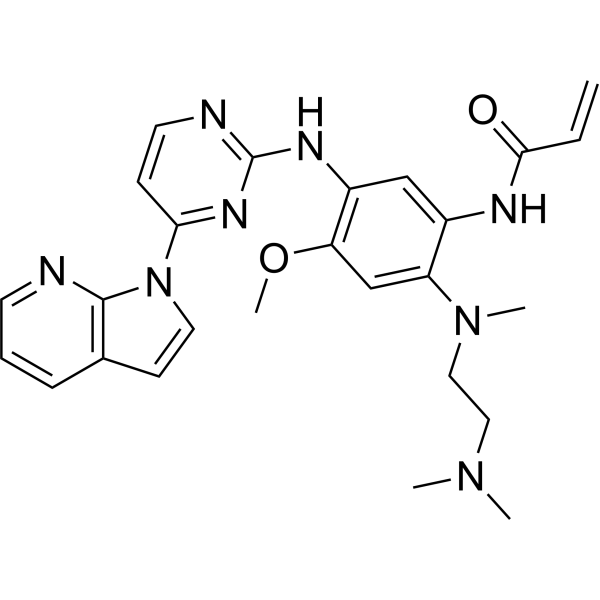
- HY-154910
-
|
|
mTOR
|
Cancer
|
|
CC214-1 is a potentially efficacious mTOR inhibitor that induces autophagy ,with an IC50 is 0.002 μM. CC214-1 proved to be useful as an in vitro tool compound for the exploration of mTOR kinase biology. CC214-1 can be used for Glioblastoma study .
|
-

- HY-111187
-
|
KX-02
|
Src
Microtubule/Tubulin
Apoptosis
|
Cancer
|
|
KX2-361 (KX-02) is a Src-kinase and tubulin polymerization inhibitor. KX2-361 shows good oral bioavailability and readily crosses the BBB in mice. KX2-361 shows anti-tumor activity and induces apoptosis of Glioblastoma (GBM) cell .
|
-
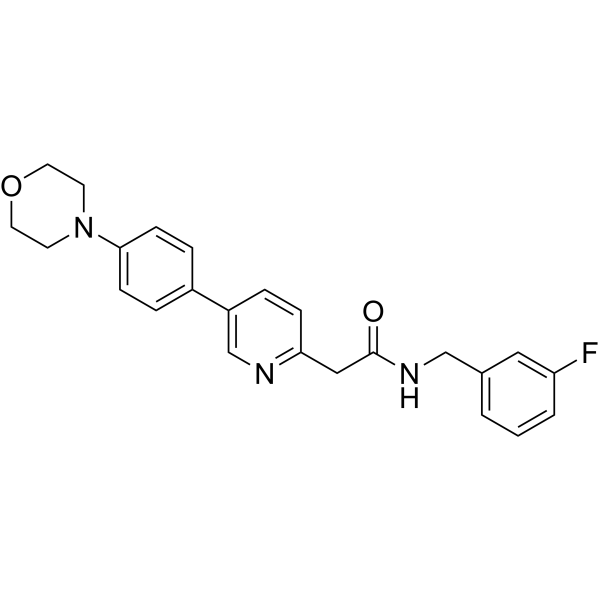
- HY-124813
-
|
113B7
|
FAK
EGFR
MMP
|
Cancer
|
|
PDZ1i is a potent, BBB-penetrated and specific MDA-9/Syntenin inhibitor. PDZ1i inhibits crucial GBM (glioblastoma multiforme) signaling involving FAK and EGFRvIII. PDZ1i reduces MMP secretion. PDZ1i can improve survival of brain tumor-bearing mice and reduce tumor invasion .
|
-
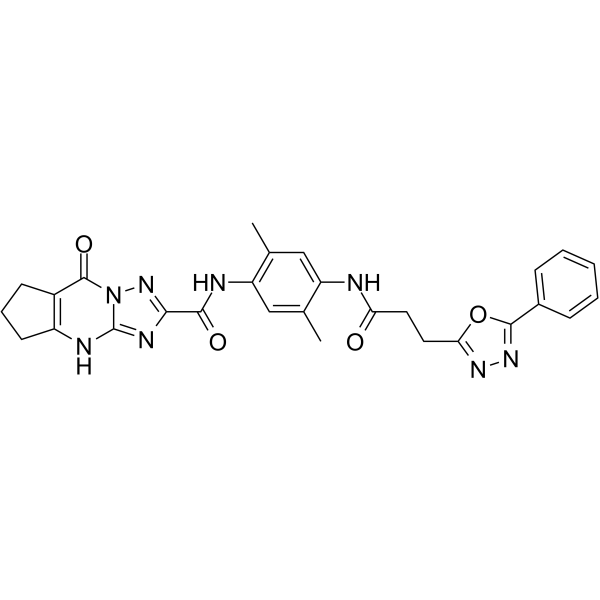
- HY-152202
-
|
|
Mitochondrial Metabolism
|
Cancer
|
|
Mitochondrial respiration-IN-3 is the fluorine derivative of Dalfopristin (HY-A0241). Mitochondrial respiration-IN-3 has cell membrane-permeable. Mitochondrial respiration-IN-3 can inhibit mitochondrial translation of glioblastoma stem cells. Mitochondrial respiration-IN-3 can be used in research of cancer .
|
-
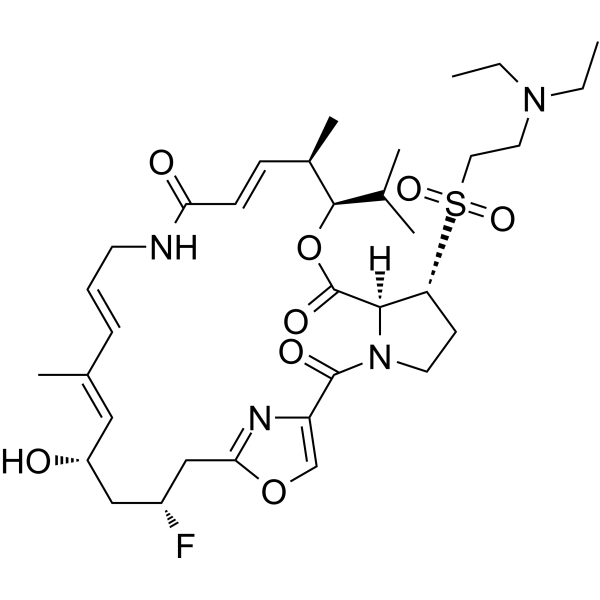
- HY-W040150
-
|
|
LXR
|
Neurological Disease
Inflammation/Immunology
Cancer
|
|
24S,25-Epoxycholesterol is an agonist for Liver X Receptor (LXR). 24S,25-Epoxycholesterol exhibits properties in regulating the cholesterol efflux , inhibiting tumor growth against gastric cancer and glioblastoma and inducing apoptosis in BMMC cells .
|
-

- HY-N0421
-
|
Cinobufagine
|
Apoptosis
|
Neurological Disease
Cancer
|
|
Cinobufagin is an anticancer agent that can be secreted by the Asiatic toad Bufo gargarizans. Cinobufagin induces the cell cycle arrests in the G1 phase or G2/M phase, leading to apoptosis in cancer cells. Cinobufagin inhibits tumor growth in melanoma and glioblastoma multiforme xenograft mouse models .
|
-

- HY-115670
-
|
|
MMP
|
Inflammation/Immunology
Cancer
|
|
GW280264X is the mixed ADAM10/TACE (ADAM17) metalloproteinases inhibitor. GW280264X potently blocks TACE (ADAM17) and ADAM10 with IC50s of 8.0 nM and 11.5 nM, respectively . ADAM10 and 17 modulate the immunogenicity of glioblastoma-initiating cells .
|
-

- HY-156432
-
|
|
Anaplastic lymphoma kinase (ALK)
mTOR
PARP
Caspase
|
Cancer
|
|
ALK-IN-26 is an ALK inhibitor with IC50 value of 7.0 μM for ALK tyrosine kinase. ALK-IN-26 has good pharmacokinetic properties and blood-brain barrier (BBB) permeability. ALK-IN-26 can induce apoptosis, autophagy and necrosis. ALK-IN-26 can be used in glioblastoma studies .
|
-
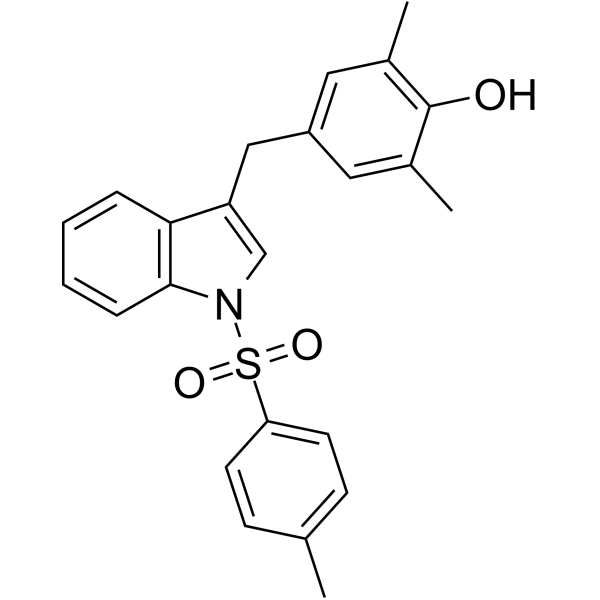
- HY-126147
-
|
|
HDAC
|
Cancer
|
|
J22352 is a PROTAC (proteolysis-targeting chimeras)-like and highly selective HDAC6 inhibitor with an IC50 value of 4.7 nM. J22352 promotes HDAC6 degradation and induces anticancer effects by inhibiting autophagy and eliciting the antitumor immune response in glioblastoma cancers, and leading to the restoration of host antitumor activity by reducing the immunosuppressive activity of PD-L1 .
|
-
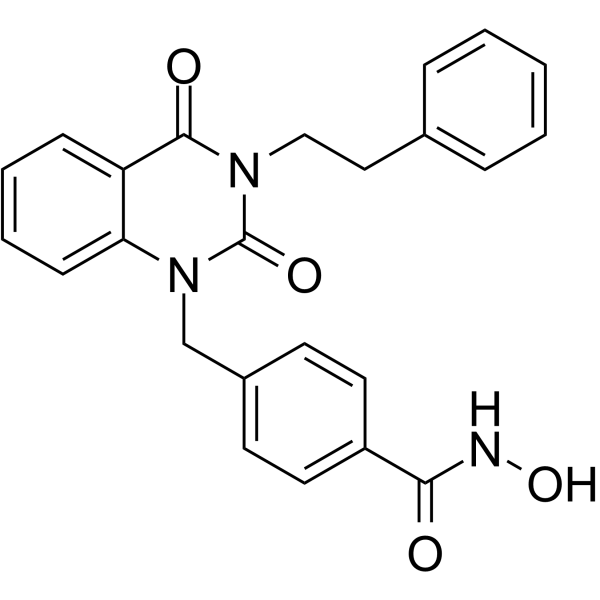
- HY-153627
-
|
|
Deubiquitinase
|
Cancer
|
|
G13KS is a deubiquitinase UCHL1 ligand and inhibitor. G13KS inhibits recombinant and cellular UCHL1. G13KS reduces levels of monoubiquitin in human glioblastoma cells . GK13S is a click chemistry reagent, it contains an Alkyne group and can undergo copper-catalyzed azide-alkyne cycloaddition (CuAAc) with molecules containing Azide groups.
|
-
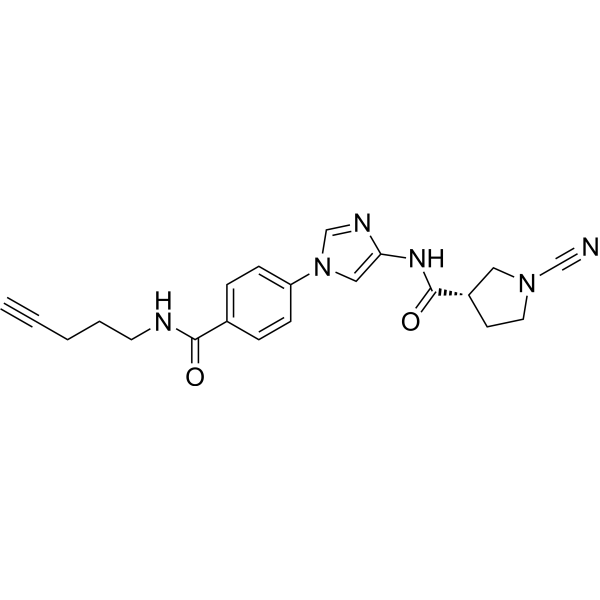
- HY-155532
-
|
|
Biochemical Assay Reagents
|
Cancer
|
|
10m/ZS44 is a blood-brain barrier-permeable Glioblastoma (GBM) inhibitor. 10m/ZS44 significantly inhibits GBM tumor growth in a mouse xenograft model. 10m/ZS44 also activates the SIRT1/p53-mediated apoptosis pathway, thereby inhibiting the proliferation of U251 cells .
|
-

- HY-161155
-
|
|
HDAC
|
Inflammation/Immunology
|
|
HDAC6-IN-31 (compound 8m) is a selective HDAC6 inhibitor, with the IC50 value of 0.026 μM, that significantly inhibits the production and release of pro-inflammatory cytokines. While HDAC6 is critically involved in the activation of inflammasomes, HDAC6-IN-31 has the potential to inhibit NLRP3 inflammasome-driven inflammatory diseases. HDAC6-IN-31 also inhibits glioblastoma cell migration .
|
-
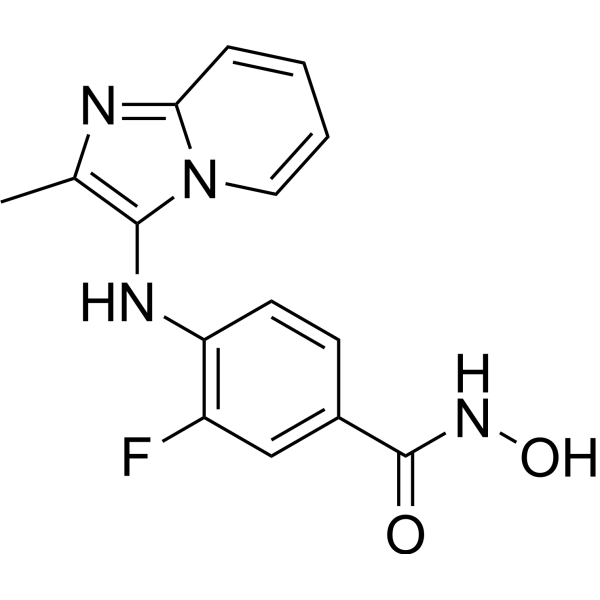
- HY-19939S
-
VX-984
4 Publications Verification
M9831
|
DNA-PK
|
Cancer
|
|
VX-984 is an orally active, potent, selective and BBB-penetrated DNA-PK inhibitor. VX-984 efficiently inhibits NHEJ (non-homologous end joining) and increases DSBs (DNA double-strand breaks). VX-984 can be used for glioblastomas (GBM) and non-small cell lung cancer (NSCLC) research. VX-984 is a de novo deuterium .
|
-
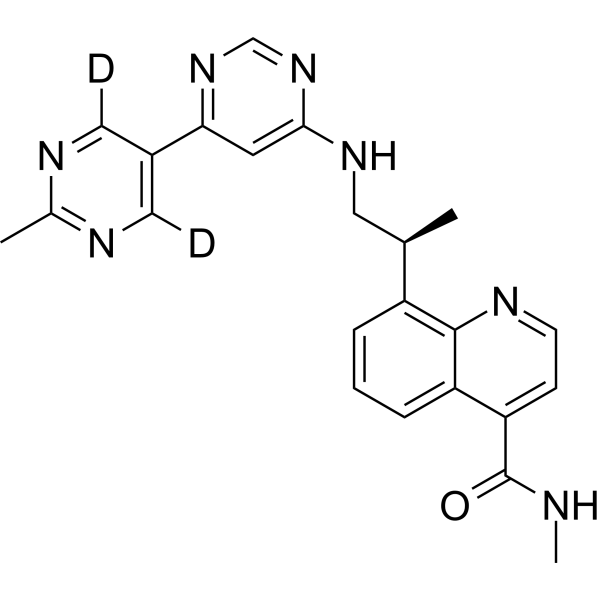
- HY-14590R
-
|
Kempferol(Standard); Robigenin (Standard)
|
Estrogen Receptor/ERR
Autophagy
Mitophagy
Apoptosis
HIV
Parasite
Endogenous Metabolite
|
Cancer
|
|
Kaempferol (Standard) is the analytical standard of Kaempferol. This product is intended for research and analytical applications. Kaempferol (Kempferol), a flavonoid found in many edible plants, inhibits estrogen receptor α expression in breast cancer cells and induces apoptosis in glioblastoma cells and lung cancer cells by activation of MEK-MAPK. Kaempferol can be uesd for the research of breast cancer .
|
-
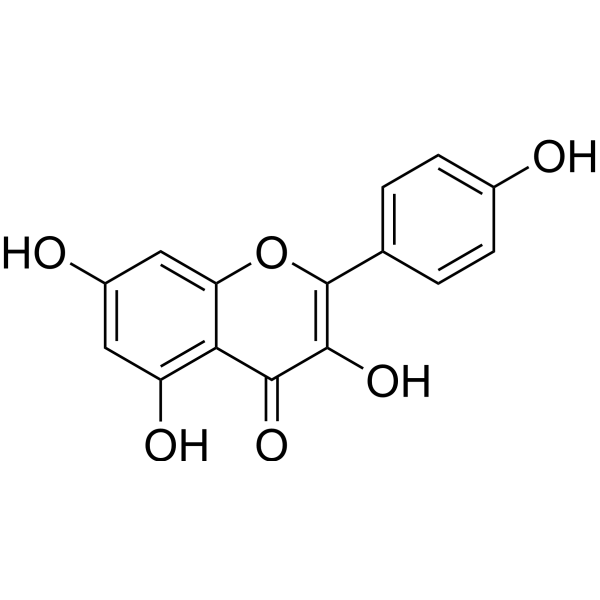
- HY-149696
-
|
|
NF-κB
|
Cancer
|
|
IR-Crizotinib is a NF-κB-inducing kinase (NIK) inhibitor that crosses the blood-brain barrier and fluorescently localizes intracranial glioblastoma (GBM) in mice (IC50=3.381 μM). IR-Crizotinib is conjugated from the near-infrared dye IR-786 and the NF-κB-inducing kinase (NIK) inhibitor Crizotinib. IR-Crizotinib can effectively inhibit the growth and invasion of glioma in vitro and in vivo and can be used in cancer research .
|
-

- HY-155458
-
|
|
PARP
|
Inflammation/Immunology
Cancer
|
|
HYDAMTIQ is a PARP-1/2 inhibitor (IC50: 29-38 nM) with anticancer, anti-inflammatory, and ischemic protective effects. HYDAMTIQ inhibits pulmonary PARP activity, is effective against allergen-induced cough and dyspnea, and inhibits bronchial hyperresponsiveness to methacholine. HYDAMTIQ has broad-spectrum tumor suppressor effects, including ovarian and breast cancers, prostate and pancreatic tumors, and glioblastoma multiforme. HYDAMTIQ has demonstrated in vivo efficacy in animal models of cerebral ischemia, asthma, cancer, and more .
|
-
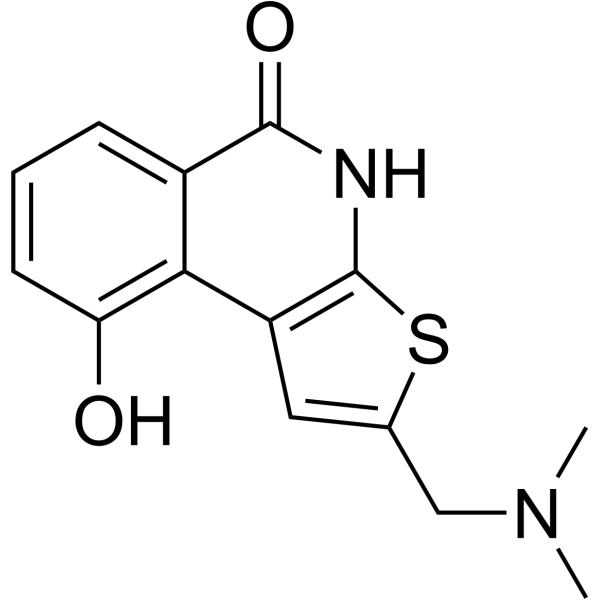
- HY-B0688S
-
|
4,4′-Diaminodiphenyl sulfone-d8; DDS-d8
|
Antibiotic
Parasite
Bacterial
Reactive Oxygen Species
|
Infection
Inflammation/Immunology
Cancer
|
|
Dapsone-d8 is a deuterium labeled Dapsone. Dapsone is an orally active and blood-brain penetrant sulfonamide antibiotic with antibacterial, antigenic and anti-inflammatory activities[1]. Dapsone exerts effective antileprosy activity and inhibits folate synthesis in cell extracts of M. leprae. Dapsone can be used as an anticonvulsant and also in the research of skin and glioblastoma diseases[2][3][4][5].
|
-

- HY-114413
-
|
|
HSP
Apoptosis
|
Cancer
|
|
YZ129 is an inhibitor of the HSP90-calcineurin-NFAT pathway against glioblastoma, directly binding to heat shock protein 90 (HSP90) with an IC50 of 820 nM on NFAT nuclear translocation. YZ129-induced GBM cell-cycle arrest at the G2/M phase promotes apoptosis and inhibited tumor cell proliferation and migration .
|
-

- HY-10261B
-
|
(E/Z)-BIBW 2992
|
|
|
|
(E/Z)-Afatinib ((E/Z)-BIBW 2992) is the mixture of (E)-Afatinib and (Z)-Afatinib. Afatinib (HY-10261) is an irreversible inhibitor of EGFR, by irreversibly binding to their ATP binding site to block activation of EGFR, HER2, HER4, and EGFRvIII. Afatinib used in co-administration with Temozolomide (HY-17364), potently targeting to EGFRvIII-cMet signaling in glioblastoma cells .
|
-

- HY-115925
-
|
|
SHP2
Phosphatase
|
Cancer
|
|
SHP2-IN-9 is a specific SHP2 inhibitor (IC50 =1.174 μM) with enhanced blood–brain barrier penetration. SHP2-IN-9 shows 85-fold more selective for SHP2 than SHP1. SHP2-IN-9 inhibits SHP2-mediated cell signal transduction and cancer cell proliferation, and inhibits the growth of cervix cancer tumors and glioblastoma growth in vivo .
|
-

- HY-108476
-
INDY
2 Publications Verification
|
DYRK
|
Cancer
|
|
INDY is a potent and ATP-competitive Dyrk1A and Dyrk1B inhibitor with IC50s of 0.24 μM and 0.23 μM, respectively. INDY binds in the ATP pocket of the enzyme and has a Ki value of 0.18 μM for Dyrk1A. INDY sharply reduces the self-renewal capacity of normal and tumorigenic cells in primary Glioblastoma (GBM) cell lines and neural progenitor cells .
|
-
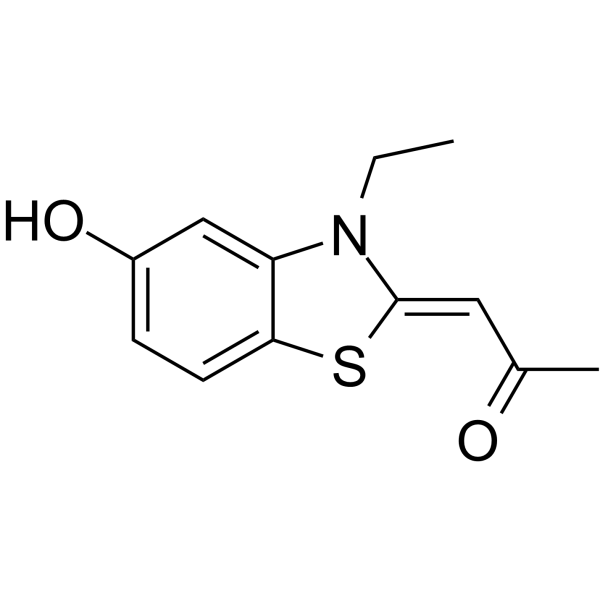
- HY-13440
-
AMG 511
2 Publications Verification
|
PI3K
|
Cancer
|
|
AMG 511 is a potent and orally available pan inhibitor of class I PI3Ks, with Kis of 4 nM, 6 nM, 2 nM and 1 nM for PI3Kα, β, δ and γ, respectively. AMG 511 significantly suppresses PI3K signaling that is indicated by p-Akt (Ser473) decrease. AMG 511 exhibits anti-tumor activity in mouse glioblastoma xenograft model .
|
-
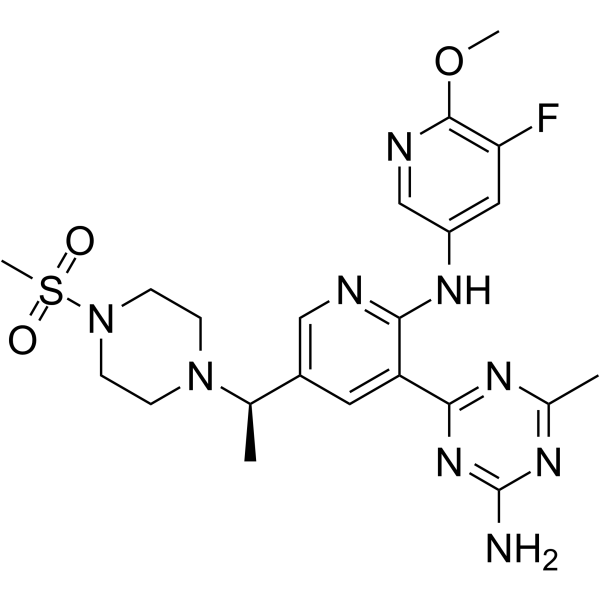
- HY-115567
-
|
1-(β-D-2-Deoxyribofuranosyl)-5-nitroindole
|
Apoptosis
|
Cancer
|
|
5-NIdR (1-(β-D-2-Deoxyribofuranosyl)-5-nitroindole), an artificial nucleoside, exhibits the ability to inhibit the replication of DNA lesions generated by Temozolomide (HY-17364). 5-NIdR induces cancer cells apoptosis and arrests cell cycle at G0 phase. 5-NIdR enhances Temozolomide anti-tumor efficacy in murine glioblastoma model .
|
-
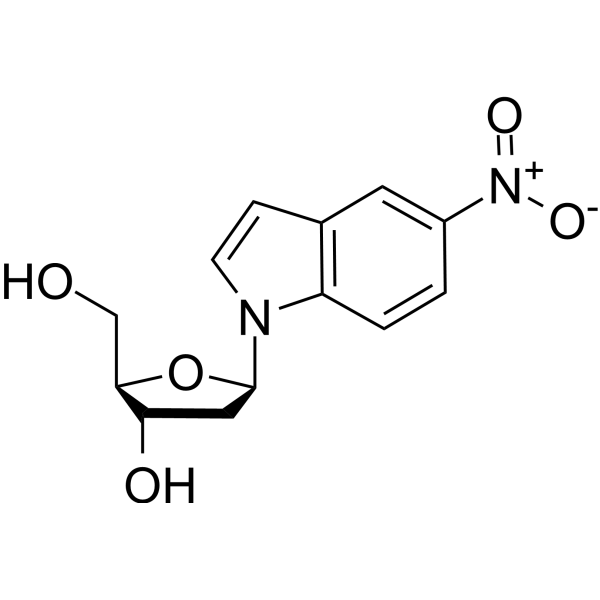
- HY-P3103
-
|
|
DNA/RNA Synthesis
|
Cancer
|
|
PINT-87aa, an 87-amino acid (aa) peptide, is encoded by the circular form of the long intergenic non-protein-coding RNA p53-induced transcript (LINC-PINT). PINT-87aa directly interacts with polymerase associated factor complex (PAF1c) and inhibits the transcriptional elongation of multiple oncogenes. PINT-87aa suppresses glioblastoma cell proliferation in vitro and in vivo .
|
-

- HY-16141
-
Cilengitide
Maximum Cited Publications
38 Publications Verification
EMD 121974
|
Integrin
Autophagy
Apoptosis
STAT
PD-1/PD-L1
|
Cancer
|
|
Cilengitide (EMD 121974) is a potent integrins antagonist with IC50s of 0.61 nM (ανβ3), 8.4 nM (ανβ5) and 14.9 nM (α5β1), respectively. Cilengitide inhibits the binding of ανβ3 and ανβ5 to Vitronectin with IC50s of 4 nM and 79 nM, respectively. Cilengitide inhibits TGF-β/Smad signaling, mediates PD-L1 expression. Cilengitide also induces apoptosis, shows antiangiogenic effect in the research against glioblastoma and other cancers .
|
-

- HY-P3103A
-
|
|
DNA/RNA Synthesis
|
Cancer
|
|
PINT-87aa TFA, an 87-amino acid (aa) peptide, is encoded by the circular form of the long intergenic non-protein-coding RNA p53-induced transcript (LINC-PINT). PINT-87aa TFA directly interacts with polymerase associated factor complex (PAF1c) and inhibits the transcriptional elongation of multiple oncogenes. PINT-87aa TFA suppresses glioblastoma cell proliferation in vitro and in vivo .
|
-

- HY-145931
-
|
|
mTOR
Autophagy
|
Cancer
|
|
CC214-2 is an oral active and selective mTOR kinase inhibitor. CC214-2 targets to both of mTORC1 (pS6) and mTORC2 (pAktS473). CC214-2 induces autophagy, which is a potential target for host-directed therapy (HDT) in tuberculosis. CC214-2 exhibits synergistic bactericidal and sterilizing activity agasinst tuberculosis (TB), and shortens the treatment duration. CC214-2 also inhibits Rapamycin (HY-10219)-resistant signaling and the growth of glioblastomas in vitro and in vivo .
|
-
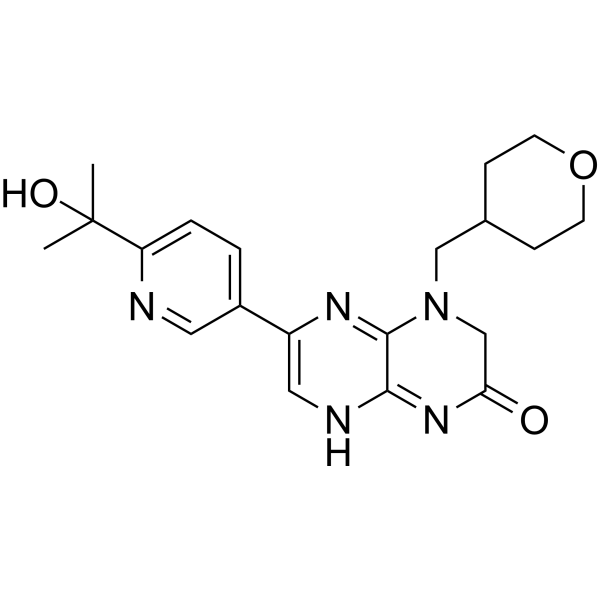
- HY-148833
-
|
|
MDM-2/p53
|
Cancer
|
|
MDM2-p53-IN-16 is a MDM2-p53 complex inhibitor with an IC50 value of 4.3 nM to dissociate human p53/MDM2 complex. MDM2-p53-IN-16 reactivates p53, and induces Glioblastoma Multiforme (GBM) cell apoptosis and cell-cycle arrest. MDM2-p53-IN-16 can be used for the cancer research .
|
-
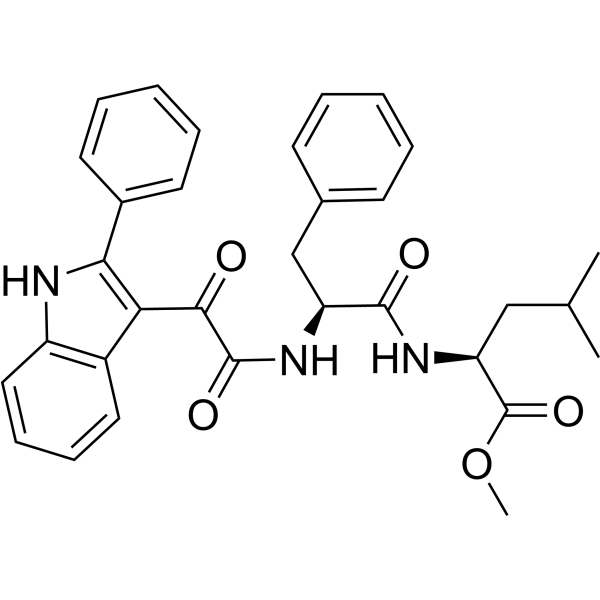
- HY-103693
-
NAZ2329
1 Publications Verification
|
Phosphatase
|
Cancer
|
|
NAZ2329, the first cell-permeable inhibitor of R5 subfamily of receptor-type protein tyrosine phosphatases (RPTPs), allosterically and preferentially inhibits PTPRZ (IC50=7.5 µM for hPTPRZ1) and PTPRG (IC50=4.8 µM for hPTPRG) over other PTPs. NAZ2329 binds to the active D1 domain and more potently inhibits PTPRZ-D1 fragment (IC50 of 1.1 µM) than the whole intracellular (D1 + D2) fragment (IC50 of 7.5 µM). NAZ2329 can effectively inhibit tumor growth of the glioblastoma cells and suppress stem cell-like properties .
|
-
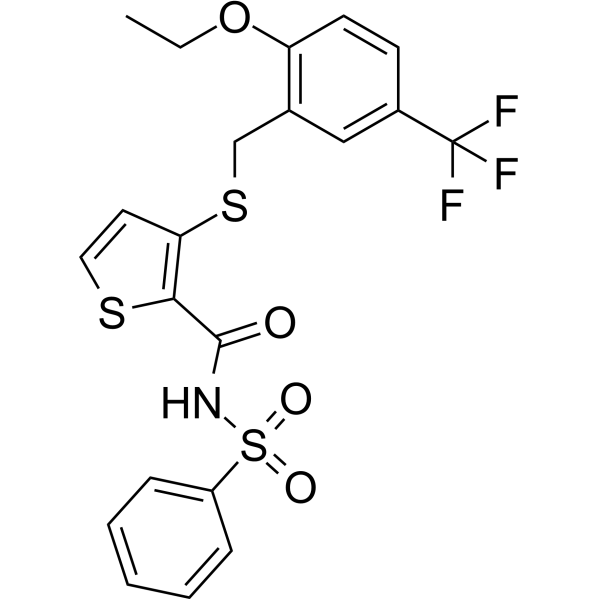
- HY-155577
-
|
|
Monoamine Oxidase
HSP
|
Cancer
|
|
MAO A/HSP90-IN-1 (4-b) is a MAO A/HSP90 dual inhibitor with IC50 value of 1.77 μM and 0.019 μM in Glioblastoma (GBM) GL26 cells and HSP90α, respectively. MAO A/HSP90-IN-1 (4-b) can inhibit MAO A activity, HSP90 binding and the expression of HER2 and phospho-Akt to inhibit the growth of GBM, they also reduce PD-L1 expression, which inhibits T cell activation. MAO A/HSP90-IN-1 (4-b) have potential to inhibit tumor immune escape. MAO A/HSP90-IN-1 (4-b) can be used for brain tumor-related diseases research .
|
-
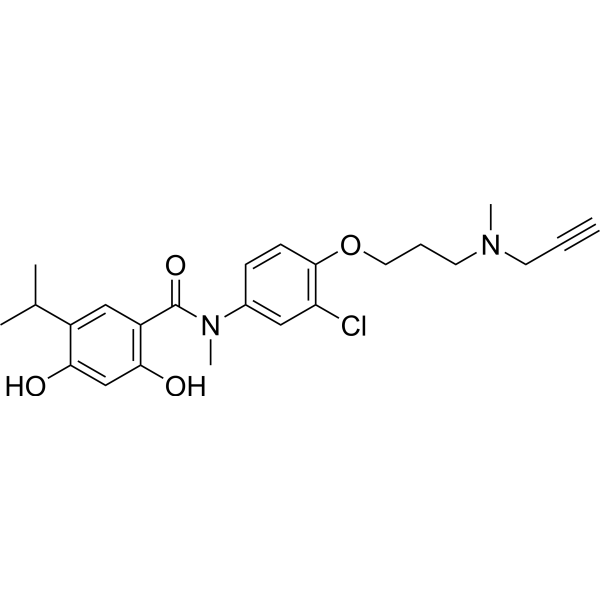
| Cat. No. |
Product Name |
Type |
-
- HY-149696
-
|
|
Dyes
|
|
IR-Crizotinib is a NF-κB-inducing kinase (NIK) inhibitor that crosses the blood-brain barrier and fluorescently localizes intracranial glioblastoma (GBM) in mice (IC50=3.381 μM). IR-Crizotinib is conjugated from the near-infrared dye IR-786 and the NF-κB-inducing kinase (NIK) inhibitor Crizotinib. IR-Crizotinib can effectively inhibit the growth and invasion of glioma in vitro and in vivo and can be used in cancer research .
|
| Cat. No. |
Product Name |
Target |
Research Area |
-
- HY-P4115
-
|
|
FABP
|
Cancer
|
|
CooP is a linear glioblastoma-targeting nonapeptide. CooP binds to the mammary-derived growth inhibitor/fatty acid binding protein 3 (FABP3) in the glioblastoma cells and its associated vasculature. CooP is used for the targeted delivery of chemotherapy and different nanoparticles .
|
-
- HY-P3990
-
|
|
VEGFR
Autophagy
Apoptosis
|
Cancer
|
|
Coibamide A, an N-methyl-stabilized cytotoxic depsipeptide, shows potent antiproliferative activity. Coibamide A induces autophagosome accumulation via an mTOR-independent mechanism. Coibamide A induces apoptosis. Coibamide A inhibits VEGFA/VEGFR2 expression and suppresses tumor growth in glioblastoma xenografts .
|
-
- HY-P3103
-
|
|
DNA/RNA Synthesis
|
Cancer
|
|
PINT-87aa, an 87-amino acid (aa) peptide, is encoded by the circular form of the long intergenic non-protein-coding RNA p53-induced transcript (LINC-PINT). PINT-87aa directly interacts with polymerase associated factor complex (PAF1c) and inhibits the transcriptional elongation of multiple oncogenes. PINT-87aa suppresses glioblastoma cell proliferation in vitro and in vivo .
|
-
- HY-P3103A
-
|
|
DNA/RNA Synthesis
|
Cancer
|
|
PINT-87aa TFA, an 87-amino acid (aa) peptide, is encoded by the circular form of the long intergenic non-protein-coding RNA p53-induced transcript (LINC-PINT). PINT-87aa TFA directly interacts with polymerase associated factor complex (PAF1c) and inhibits the transcriptional elongation of multiple oncogenes. PINT-87aa TFA suppresses glioblastoma cell proliferation in vitro and in vivo .
|
| Cat. No. |
Product Name |
Target |
Research Area |
-
- HY-P99768
-
|
TTAC-0001
|
VEGFR
|
Cancer
|
|
Olinvacimab (TTAC-0001) is a fully human anti-VEGFR2 monoclonal antibody. Olinvacimab inhibits VEGF binds to KDR with a Kd value of 0.23 nM. Olinvacimab has antiangiogenic activity. Olinvacimab can be used for the research of recurrent glioblastoma and breast cancer .
|
| Cat. No. |
Product Name |
Category |
Target |
Chemical Structure |
| Cat. No. |
Product Name |
Chemical Structure |
| Cat. No. |
Product Name |
|
Classification |
-
- HY-153627
-
|
|
|
Alkynes
|
|
G13KS is a deubiquitinase UCHL1 ligand and inhibitor. G13KS inhibits recombinant and cellular UCHL1. G13KS reduces levels of monoubiquitin in human glioblastoma cells . GK13S is a click chemistry reagent, it contains an Alkyne group and can undergo copper-catalyzed azide-alkyne cycloaddition (CuAAc) with molecules containing Azide groups.
|
Your information is safe with us. * Required Fields.
Inquiry Information
- Product Name:
- Cat. No.:
- Quantity:
- MCE Japan Authorized Agent:



























































































